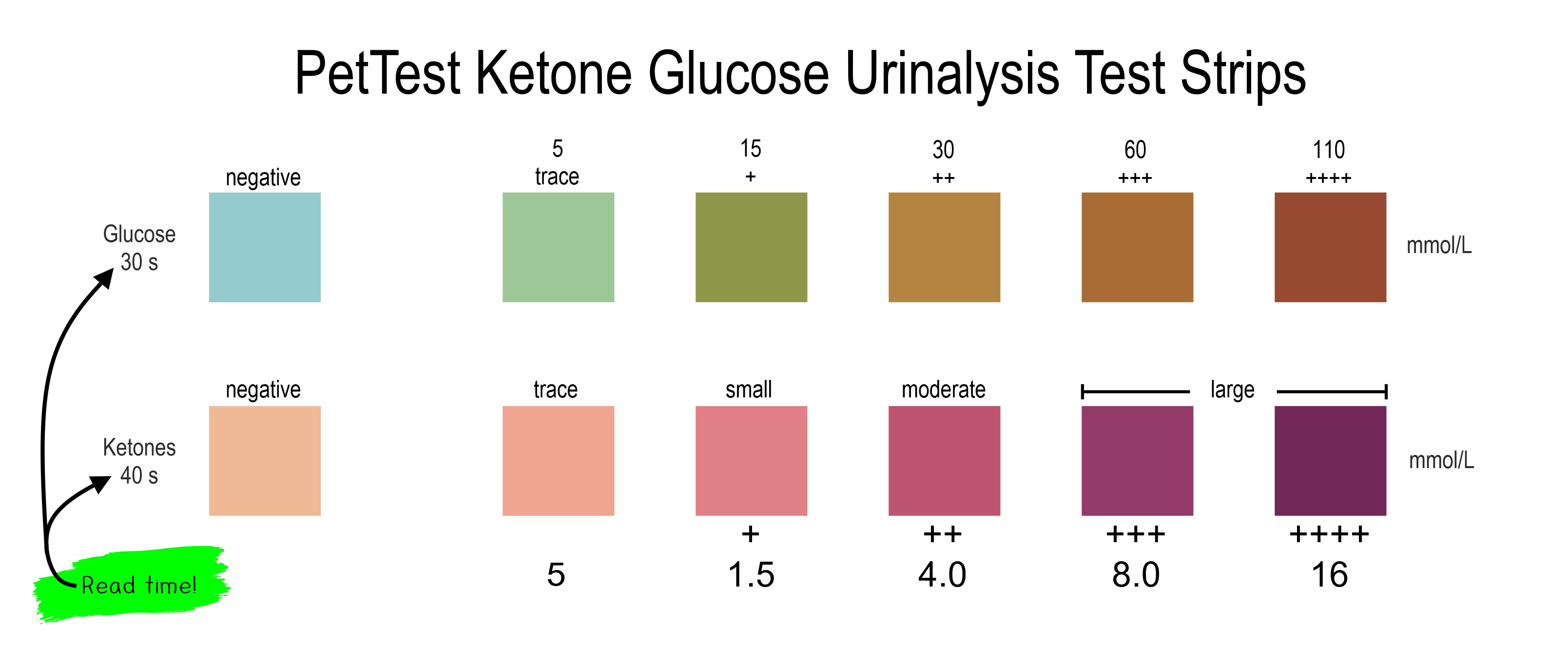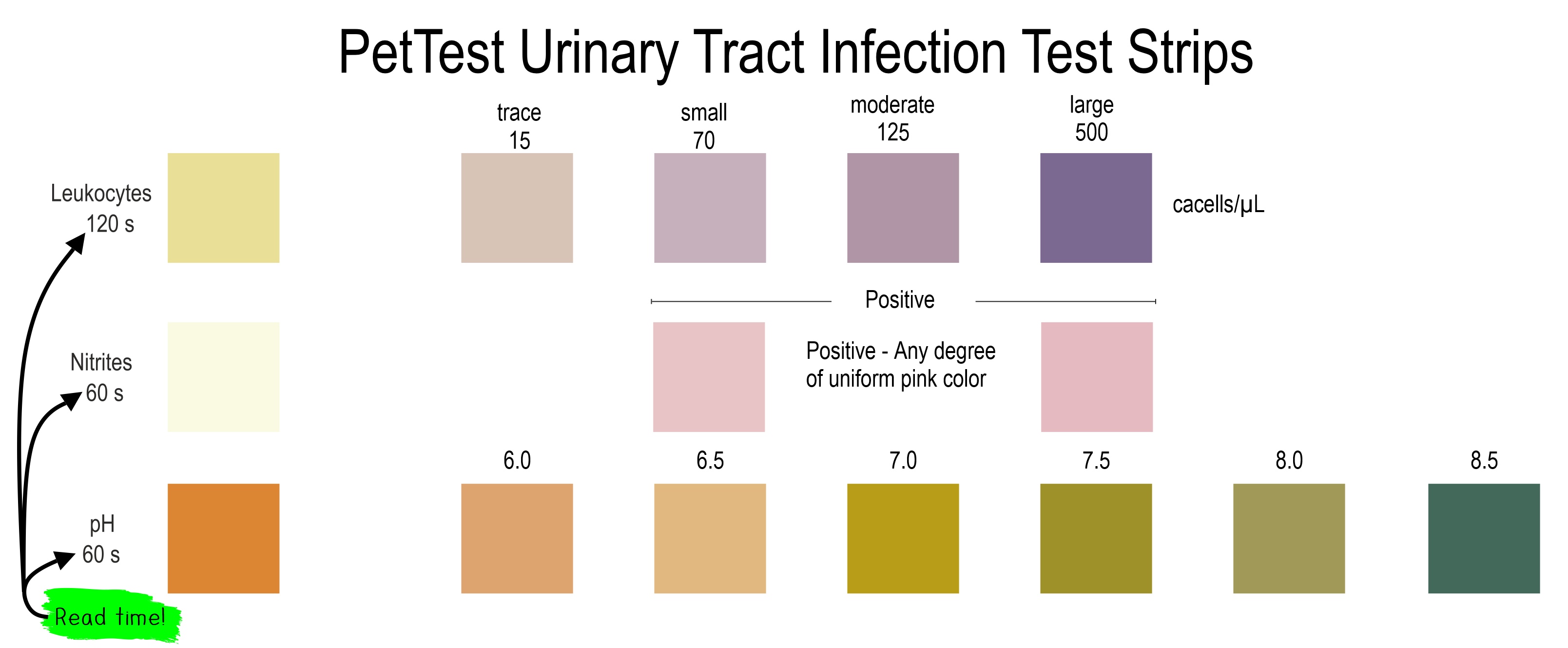How to Read Urine Test Strips
After Lucy was diagnosed with diabetes I tested blood glucose levels faithfully and I also tested urine for ketones whenever her blood glucose was over 300 mg/dL (16.66 mmol/L). I had urinary tract infection test strips on hand as well to rule out a possible UTI. These are all great tools to have on hand, I knew if I had to get her into the vet’s office and I was able to give the vet a bit of insight as to what was going on.
I did have the 10 parameter urine test strips but in my opinion they were hard to read since some results are in 30 seconds, some are 60 seconds and others are 120 seconds. Trying to quickly decipher multiple results at the 30 seconds mark is hard and frustrating. I also found that once the test strips are wet, the colors can bleed.
Today I am going to go over how to read urine test strips, what those results can mean and some tips on getting a urine sample from your pup.
Grab a cup of your favorite caffeinated beverage and let’s get to it!
Reading urine test strips is not hard but they need to be read at the appropriate time. Make sure you find the read time on the test strip bottle before you dip them into the urine sample. Ketone, glucose, leukocytes, nitrites and pH all read at various times. Read times vary between different test strip manufacturers so always check your new bottle of test strips. Urine test strips have expiration dates, so make sure you write down the date you opened them; typical expiry date after opening urine test strips is 90 days.
Familiarize yourself with the color chart on the test strip bottle, this will help when it is time to read the test strip results.


Let’s go over what each reading is for, normal ranges and what results MAY indicate.
Glucose
The kidneys dump glucose into the bladder once blood glucose levels hit approximately 180 mg/dL (10 mmol/L). Trace to small amounts of glucose should always be in a diabetic dog’s urine, this ensures that we are not running them too low.
Don’t forget that it is not recommended to gauge insulin dosing by glucose urine test strips, since the kidneys dump glucose into the bladder multiple times before the bladder is emptied, the information is pooled and old.

Ketones
Ketones are a byproduct of uncontrolled diabetes. When there is not enough insulin to open cells to uptake glucose, the liver produces ketones for energy. Ketones are toxic acids that builds up in the blood stream and causes diabetic ketoacidosis (DKA).
Ketones should always be negative in a diabetic dog’s urine. Trace amounts of ketones can be flushed out by encouraging water consumption but anything higher requires vet intervention.

Leukocytes
Also known as white blood cells (WBC) are part of the body’s immune system that fight off infection. Higher levels of leukocytes in the can indicate infection like a urinary tract infection (UTI). Antibiotics may be necessary and a vet visit is in order if your dog’s urine is positive for leukocytes.

Nitrites
Nitrates are found in urine; if bacteria enter the urinary tract nitrates can turn into nitrites. Presence of nitrites can be a sign of a urinary tract infection (UTI) and a vet visit along with a urinalysis is necessary to rule out infection.

pH
The normal pH range of dog urine is 7.0 – 7.5. The higher the pH the more alkalinity urine is. The lower the pH the more acidic urine is.
Higher pH (alkalinity) may indicate sign of urinary tract infection (UTI) and higher pH can allow crystals or stones to form in the bladder. Low pH (acidic) can be indicative of kidney disease, uncontrolled blood glucose and diarrhea.

Catching urine can be tricky especially if your dog is short or doesn’t like you behind them when they are doing their business. Here are several suggestions for catching urine.
- A cup
- Container
- Cup taped to a stick
- Pee pad turned upside down
- Telescoping urine catcher – can be purchased on Amazon, click here.
Having these supplies in your diabetes arsenal will help you stay on top of your diabetic dog’s health and gives good insight to when a vet visit is in order. I always had urine test strips on hand and used them more than several times over the course of four and a half years.
If you need test strips you are in luck, PetTest offers them!
https://shoppettest.com/ketone-strips-for-pets/
https://shoppettest.com/pettest-urinary-tract-infection-test-strips-for-pets-2-packs-of-50/
If you have any questions, comments or suggestions, please start a conversation below.
Until next week stay comfy, cool and caffeinated!
~ Michelle Miller-Matlock
- AAHA Certified Diabetes Educator
- Administrator of Diabetic Dog Owners on Facebook
- Founder/Administrator of DDO: Diabetic Dog Owners University
Want to learn all you can in a simple and easy to follow format? Please join DDO: Diabetic Dog Owners University, sponsored by PetTest.
Be sure to join the PetTest family on Facebook and Instagram. PetTest has fun, interactive posts AND they have fabulous giveaways every week!
Do you need a blood glucose meter kit for your diabetes arsenal? Click here.
For a printable version of this blog click here.

